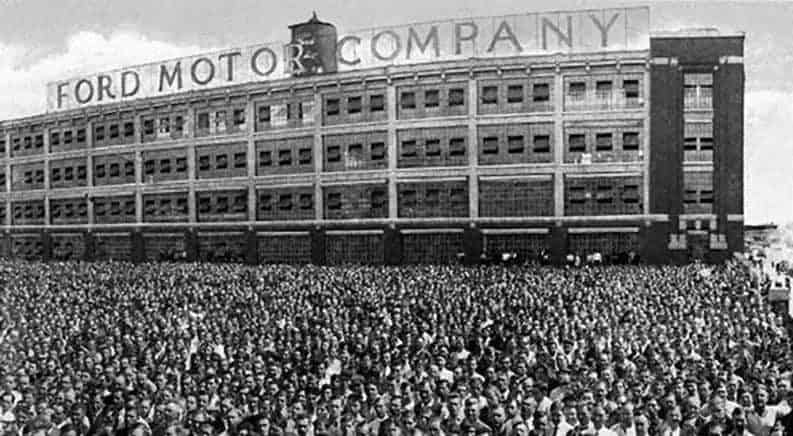It’s impossible to think about Ford dealerships without thinking about Ford’s long history as a company in America. It’s a legend that we as Americans love. The Ford story celebrates the entrepreneurial spirit, technological innovation, and the power of one big idea—like the assembly line. Let’s take a look at the history of Ford dealerships and how that history has affected Ford in the modern era.
1896-1903: Early Days Through Incorporation
When Henry Ford, the founder of Ford Motor Company, built his first vehicle in a workshop behind his home in 1896, he didn’t call it a car. He named the device the Quadricycle—a vehicle equipped with four bicycle wheels and a four-horsepower engine to get around. The Quadricycle’s driver navigated with a tiller, instead of using a steering wheel to guide its path. Shoppers at early Ford dealerships could choose between two forward gears, as there was no reverse.
At the time, Ford was the chief engineer of the Detroit Edison Illuminating Company. Prior to 1903, he’d tried to begin a business in the car industry twice before. It wasn’t until the 1903 incorporation of Ford Motor Company that he was successful.
The first Model A Ford was sold to a customer July 23, 1903. By that time, the company was scraping the bottom of the barrel of its initial cash investments of $28,000. By October 1 of that same year, however, the Ford Motor Company had made $37,000 in profit. That’s over 1 million dollars in 2016-equivalent funds.
Ford’s first workshops built only a few cars per day, with small teams of workers assembling the cars by hand from pieces custom-built by other companies. Their early successes laid the path for Ford to become the respected, iconic business it is today. The American countryside is now dotted with Ford dealerships along its highways, just as Model A Fords began to appear frequently on the road in the early days.
1908: Enter the Model T Ford
Between the Model T Ford’s introduction in 1908 and 1927, when the last of these classic cars rolled out of the factory, customers had purchased 15 million Model Ts. After 10 years of manufacturing, nearly half the cars in America were Model Ts, also called “Tin Lizzies.”
This uptick in demand and production meant those early Ford dealerships had to get creative to continue meeting customers’ needs as times changed. In response, these early Ford dealerships developed some of the first methods of mass production, such as larger production plants, standard parts that were interchangeable, and the first integrated moving assembly line to produce cars in 1913. The assembly line transformed Ford’s process: Instead of it taking 12.5 hours to assemble a Ford car, workers could now do it in an hour and a half.
Ford even doubled daily pay for his workers in 1914 (up to $5 from $2.34), also reducing their shifts from nine hours to eight, and this rate became the new industry standard. The eight-hour schedule let Ford squeeze in three working shifts per day instead of the previous two.
Late 1910s-Early 1920s: the River Rouge Complex Plant
Ford had been using assembly plants for a while (in Kansas City, Missouri, and Manchester, England, for example). However, the plant located in Dearborn, Michigan along the River Rouge was groundbreaking in that it would include everything Ford dealerships needed to assemble a complete vehicle under one roof. In addition to the assembly line, workers would also have access to a steel mill, tire factory, power plant, and glass factory to create the parts they needed to assemble a Ford.
By the 1930s, more than 100,000 workers made their careers in the River Rouge Complex. In fact, it still functions, having been updated over the years to use new technologies. Today, a car is completed in the River Rouge Complex every few seconds.
1930s-1940s: A Time of Growth and Time of War
Ford dealerships saw lots of changes in the 1930s as the company began to expand its offerings. In 1932, Ford produced its first vehicle with a V8 engine. This initiative was quickly followed by the Lincoln Zephyr and Mercury brands.
As the 1940s began, Ford dealerships began directing more resources toward producing Jeeps for the U.S. Military. In fact, the name “Jeep” comes from the vehicles’ abbreviated designation: GP, or “general purpose.” As World War II got underway in 1942, Ford temporarily stopped producing cars for civilians. Instead, the company focused attention and resources instead on vehicles, aircraft or aircraft engines, tanks, and other products valuable to the war effort.
This flexibility to continue trying new product lines kept its image from becoming stagnant. Not to mention, Ford’s willingness to put commercial business on hold to support the war effort ingrained the brand in consumers’ minds as an American cornerstone.
1950s-1960s: Ford Becomes a Cultural Icon
The 1950s and ‘60s saw developments that changed the way Americans view Ford dealerships. With the appearance of the Thunderbird in 1954 and the Continental and Edsel in the mid-to-late-’50s, Americans saw that Ford would not be a one-note company, forever defined by its success with the Model T. The Mustang in 1964 would be the next iconic Ford American vehicle.
Ford made other changes to diversify during this period in ways beyond its offered car models. In the 1950s, Ford began crash testing its vehicles (and now they also do crash test simulations). The company became publicly traded in 1956, and Ford Credit began to offer loans and leases in 1959. Ford-owned Philco in the 1960s designed, created, staffed, and equipped the Mission Control Center that kept astronauts in touch during the moon landing and later space program initiatives.
These additional lines of business kept Ford an agile company and ensured that customers would think of the American Ford dealership as safe, convenient, and technologically savvy.
From History to the Modern Day
These bits of biography on the Ford Motor Company aren’t just interesting historical tidbits—they make up the framework of how customers view Ford dealerships today. Ford is a name that’s connected to innovation in production and efficiency as well as a focus on keeping up with the latest in technology and safety. Ford dealerships are at the heart of a company with history—a company customers trust, with cars that are embedded in our American culture and history.
It’s not surprising that the modern Ford dealership business still illustrates this deep history. For example, a 2003 NPR article celebrated a family in Minnesota who has been running a Ford dealership and selling Ford vehicles for an entire century. Five generations of the family have chosen work at the Ford dealership as their career path.
In fact, Ford hasn’t stopped looking for ways to streamline the production of its vehicles and maximize efficiency. In 2017, by using the three-shift, or crew, model, production time available in Ford factories will increase by over 30%.
“One hundred years ago, my great-grandfather had a vision to build safe and efficient transportation for everyone,” said Ford Executive Chairman Bill Ford. “I am proud he was able to bring the freedom of mobility to millions by making cars affordable to families and that his vision of serving people still drives everything we do today.”




